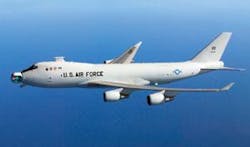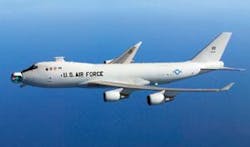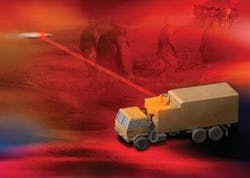Weapons at the speed of light
By Courtney E. Howard
Laser weaponry will be a tool in the U.S. military’s arsenal much sooner than many think, with the first applications for missile defense from the ground and the air.
Leading the way is the U.S. Missile Defense Agency’s (MDA’s) Airborne Laser (ABL), expected to be fielded within the next few years. Perhaps the MDA’s most famous program, the Airborne Laser is designed to destroy missiles in their boost phase.
“ABL, with its future capability to destroy a missile in flight, is a critical and necessary component of an integrated missile defense system,” says Alexis Livanos, corporate vice president and president of the Northrop Grumman Space Technology sector in Redondo Beach, Calif.
“The high-energy COIL laser beam, traveling at the speed of light, coupled with the operation of the beacon illuminator that is used for atmospheric compensation, are examples of how we are employing Northrop Grumman advanced technologies to defend our nation and its assets,” Livanos says.
The operational phase of the ABL begins with the six strategically placed infrared sensors that detect the exhaust plume of a boosting missile. Once a target is detected, a kilowatt-class laser, the Track Illuminator (TILL), tracks the missile and determines a precise aim point.
The Beacon Illuminator (BILL), a second kilowatt-class laser, then measures disturbances in the atmosphere, which are corrected by the adaptive optics system to point and focus the high-energy laser at its intended target. Using a large telescope located in the nose turret of the ABL aircraft—a modified Boeing 747 jetliner—the beam control/fire control system focuses a separate megawatt-class laser beam onto a pressurized area of the boosting missile, holding it there until the concentrated energy causes the missile to break apart, according to the MDA. Contrary to what many may think, the ABL high-energy laser does not explode the missile, but rather heats it to such an extent that it implodes.
This past summer, the Boeing-led ABL team tracked an airborne target, compensated for atmospheric turbulence, and fired a surrogate for its high-energy laser.
During the test, the ABL 747-400F aircraft took off from Edwards Air Force Base, Calif., and used its infrared sensors and its TILL to find and track an instrumented target board located on the U.S. Air Force’s NC-135E Big Crow test aircraft. The Big Crow then fired its beacon laser at the ABL aircraft to enable ABL to measure and compensate for laser-beam distortion caused by the atmosphere. Lastly, ABL fired the surrogate high-energy laser (SHEL) at the Big Crow target board to simulate a missile shootdown. With the exception of ABL’s BILL, this flight test demonstrated the entire engagement sequence from target acquisition to pointing and firing the SHEL.
“This successful test shows that ABL can find and track a target, use its beam control/fire control system to compensate for atmospheric turbulence, and fire a surrogate high-energy laser to simulate a missile intercept,” says Pat Shanahan, vice president and general manager of Boeing Missile Defense Systems in Washington. “We have now demonstrated most of the steps needed for the Airborne Laser to engage a threat missile and deliver precise and lethal effects against it.”
In upcoming flight tests, ABL will again demonstrate the engagement sequence, but this time use the return from its BILL instead of the Big Crow’s beacon laser to measure atmospheric distortion.
The program will install the actual Northrop Grumman-built high-energy laser in the aircraft to prepare for the first intercept test against an in-flight ballistic missile in 2009. The high-power chemical laser has completed rigorous ground testing at Edwards Air Force Base and is being prepared for installation, Boeing officials say.
Boeing is the prime contractor for ABL, which will provide a speed-of-light capability to destroy all classes of ballistic missiles in their boost phase of flight. Boeing provides the modified aircraft and the battle-management system and is the overall systems integrator. ABL partners are Northrop Grumman, which supplies the TILL and BILL high-energy lasers, and Lockheed Martin, which provides the nose-mounted turret and the beam control/fire control system.
Northrop Grumman mobile lasers
The U.S. Army has selected the Northrop Grumman Space Technology segment for the first phase of a program to demonstrate a mobile, solid-state laser weapon system mounted on a ground vehicle. The High Energy Laser Technology Demonstrator (HEL TD) is intended to counter rockets, artillery, and mortars (counter-RAM) at the High Energy Laser Systems Test Facility (HELSTF) at White Sands Missile Range, N.M.
If deployed, HEL TD could support the transition to an Army acquisition program.
Northrop Grumman Space Technology won a one-year, $8 million contract, which could reach nearly $50 million over three years if options are exercised, from the Army Space and Missile Defense Command in Huntsville, Ala. Under the contract, Northrop Grumman is designing a ruggedized beam-control subsystem deployed on a tactical combat vehicle.
“We have built and tested a counter-RAM laser beam control system and integrated it with a command-and-control system to detect, track, and destroy incoming threats in flight,” Dan Wildt, director of Northrop Grumman’s Directed Energy Systems, says. These accomplishments include hand-off from an acquisition radar, passive and active tracking of targets, aim-point maintenance, and predictive avoidance.
The HEL TD team led by Northrop Grumman consists of BAE Systems, Ball Aerospace & Technologies, and L-3 Communications Brashears. Northrop Grumman will provide systems engineering, system integration, the beam control subsystem, the power subsystem, the thermal subsystem, and C3I. BAE Systems will provide the vehicle and platform integration; Ball Aerospace & Technologies Corp. will supply beam alignment and stabilization systems; and L-3 Communications Brashears will supply the beam director.
Northrop Grumman Corp. officials also opened a specialized facility in Redondo Beach, Calif., exclusively for the system integration and production of high-energy laser systems for the military. The Directed Energy Production Facility is specifically designed for the production of high-energy, solid-state lasers and their integration onto military vehicles.
The facility’s first project is to build and demonstrate the first 100-kilowatt solid-state laser sufficient for Phase 3 of the Joint High-Power Solid State Laser (JHPSSL) program.
High-energy liquid lasers
Officials at the Defense Advanced Research Projects Agency (DARPA) in Arlington, Va., have contracted professionals at Textron Defense Systems, an operating unit of Textron Systems Corp. in Wilmington, Mass., to design the unit cell module for a 150-kilowatt laser weapon system (LWS) as part of the High Energy Liquid Laser Area Defense System (HELLADS) program.
The goal of HELLADS is to develop a high-energy laser weapon system, on the order of 150 kilowatts, that also is smaller and lighter than existing laser systems. With a weight goal of less than 11 pounds per kilowatt, HELLADS will enable high-energy lasers (HELs) to be integrated onto tactical aircraft. The compact system is intended to shoot down tactical targets, such as surface-to-air missiles and rockets, and to overcome the engagement-range limitations of larger, ground-based systems.
Based on the $1.45 million contract, Textron engineers are designing a unit cell laser module with integrated power and thermal management. It must be capable of 17 kilowatts of output power and meet DARPA’s aggressive weight, volume, beam quality, and runtime requirements for the LWS. Textron Defense Systems’ design is based upon the company’s ThinZag Ceramic solid-state laser technology. If the module proves successful, additional laser modules will be fabricated to produce a 150-kilowatt laser, which will be integrated with an existing beam-control solution to produce a laser weapon system demonstrator, Textron officials say.
“This DARPA initiative allows us to demonstrate compact, scalable, laser weapon system architectures based on ThinZag technology and accelerate the deployment of directed-energy weapons to the warfighter,” says Dr. John Boness, vice president, Applied Technology, Textron Defense Systems’ Advanced Solutions Center in Wilmington, Mass.
The HELLADS program also is funding the Aero Adaptive Beam Control program, designed to optimize the performance of high-energy lasers on tactical aircraft against targets in the aft field of regard. Current optical turret designs protrude, causing severe aero-optic distortions due to turbulence in the wake and unsteady shock movement over the aperture, reducing the effectiveness of directed-energy weapons. This program will examine flow-control strategies, explore the feasibility of a flow-control system synchronized with adaptive optics, and potentially culminate in wind-tunnel testing and the demonstration of an adaptive optics system and flight test turret.


